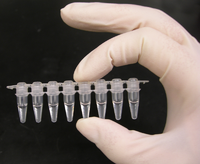
Photo from wikipedia
PD-L1 immunohistochemistry (IHC) currently has the most Food and Drug Administration (FDA) approvals as a companion diagnostic (CDx) for immunotherapies in specific tumor types; however, multiple other immunotherapy biomarkers exist.… Click to show full abstract
PD-L1 immunohistochemistry (IHC) currently has the most Food and Drug Administration (FDA) approvals as a companion diagnostic (CDx) for immunotherapies in specific tumor types; however, multiple other immunotherapy biomarkers exist. We performed this study to examine and report the prevalence of PD-L1 expression in a wide variety of tumor types and examine its relationship to microsatellite instability (MSI), tumor mutational burden (TMB), and CD274 (PD-L1) gene amplification. We performed a retrospective analysis of all cases in which both PD-L1 IHC (using the DAKO 22C3 IHC assay with either tumor proportion score (TPS) or combined positive score (CPS); or the VENTANA SP142 assay with infiltrating immune cell score (IC)) and comprehensive genomic profiling (CGP) were tested at Foundation Medicine between January 2016 and November 2019. Of note, PD-L1 positivity is defined per the CDx indication and tumor proportion score (TPS ≥ 1) for indications without a CDx claim; and TMB positivity is defined as ≥10 mutations/Mb. A total of 48,782 cases were tested for PD-L1 IHC and CGP. Immune cell expression of PD-L1 was more frequently identified than tumor cell expression of PD-L1. We saw a high correlation between PD-L1 expression and CD274 gene amplification (p < 0.0001), MSI and TMB (p < 0.0001), and PD-L1 and TMB (p < 0.0001). In addition, the combination of PD-L1 and TMB identified four unique disease subsets PD-L1−/TMB−, PD-L1+/TMB−, PD-L1−/TMB+, and PD-L1+/TMB+ with varying prevalence dependent on tumor type. Lastly, 50.3% (24527/48782) of the overall cohort was positive for at least one of the CDx or exploratory biomarkers described above. This is the largest pan-cancer analysis of relevant biomarkers associated with response to checkpoint inhibitors to date, including more than 48,000 cases. Additional clinical trials with treatment outcome data in individual tumor types are needed to determine whether the double positive PD-L1+/TMB+ disease subset would respond best to immunotherapy.
Journal Title: Modern Pathology
Year Published: 2020
Link to full text (if available)
Share on Social Media: Sign Up to like & get
recommendations!